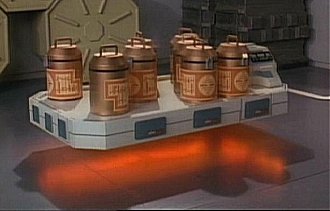|

In Star
Trek, anti-grav units were device capable of nullifying the force of
gravity and were used to lift loads of an extremely high mass. These
were available as hand-held devices, in the form of pallets or as
larger anti-grav sleds. Another form of the device - the
anti-grav lift - was to carry away wounded crew members. The exact form
of this gravity-manipulating technology is never explained but it
presumably worked along the same gravitational shielding principles as
the artificial gravity systems in Starships, only in reverse.
In real science, such feats of levitation have been accomplished using
giant superconducting magnets that create a magnetic field that
distorts the orbits of the electrons in the atoms of any object placed
in its path. In 1997, a team led by Andrey Geim managed to levitate
several small objects, including live frogs, mice, and grasshoppers, in
a large magnetic field at the High Field Magnet Laboratory in the
Netherlands.
|

Anti-grav sled
|
Such technology, however, does not
actually manipulate gravity - it only overcomes it. In 1992, a Russian
scientist Yevgeny Podkletnov reported producing a true anti-gravity or
gravitational shielding effect using a device consisting of a spinning,
super-conducting ceramic ring, solenoids that generated a magnetic
field and liquid nitrogen acting as a coolant. Recent work done by
Martin Tajmar supported by the European Space Agency demonstrated that
an acceleration field can be induced by applying angular accelerations
to a superconductor. This superconductive gyroscope was capable of
generating a powerful gravitomagnetic field - the gravitational
counterpart of the magnetic coil. By allowing force-carrying
gravitational particles, known as the gravitons, to become heavier,
they found that the unexpectedly large gravitomagnetic force could be
modelled. Further developments on superconductors and gravitomagnetic
technology could well yield devices that could leviate objects,
generate tractor beams and be the basis for a general-purpose force
field.

|

The Podkletnov Experiment
|



